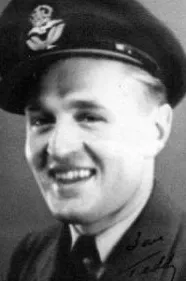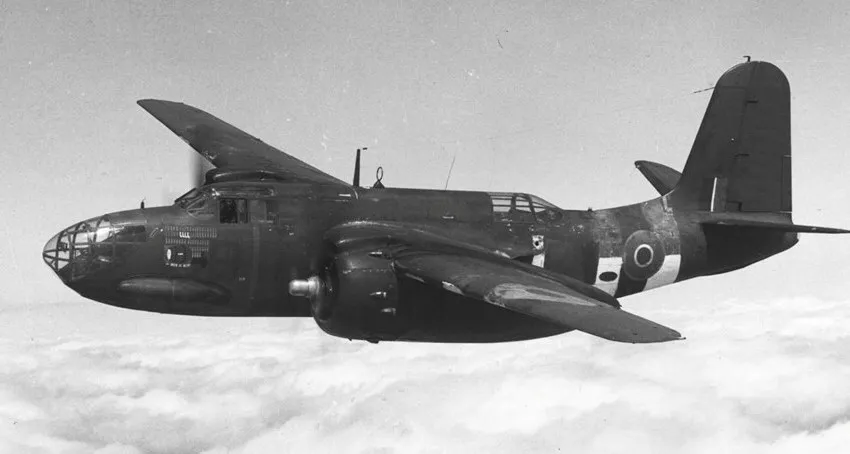Zadworny, Thaddeus John Bernard (Flying Officer)
Killed in Action 1944-May-22


Birth Date: 1922-March-25
Born: Ituna, Saskatchewan
Parents: Son of Mr. and Mrs. J. B. Zadworny, of Ituna, Saskatchewan.
Spouse:
Home: Ituna, Saskatchewan
Enlistment: Saskatoon, Saskatchewan
Enlistment Date: 1940-October-17
Service
RCAF
Unit
114 Sqn- Squadron
Base
Rank
Flying Officer
Position
Pilot
Service Numbers
J/15816
Home
Crew or Other Personnel
Boston BZ228
Boston serial: BZ228

Douglas Boston Mk. III, RAF No. 88 Squadron, c1944
The Douglas A-20 Havoc (company designation DB-7) is an American medium bomber, attack aircraft, night intruder, night fighter, and reconnaissance aircraft of World War II. Designed to meet an Army Air Corps requirement for a bomber, it was ordered by France for their air force before the USAAC decided it would also meet their requirements. French DB-7s were the first to see combat; after the fall of France the bomber, under the service name Boston continued with the Royal Air Force. From 1941, night fighter and intruder versions were given the service name Havoc. In 1942 USAAF A-20s saw combat in North Africa.
In most British Commonwealth air forces, the bomber variants were known as Boston, while the night fighter and intruder variants were named Havoc. The exception was the Royal Australian Air Force, which used the name Boston for all variants. In March 1936, a design team headed by Donald Douglas, Jack Northrop, and Ed Heinemann produced a proposal for a bomber-reconnaissance aircraft powered by a pair of 450 hp (340 kW) Pratt & Whitney R-985 Wasp Junior radial engines mounted on a shoulder wing. It was estimated to be capable of 250 mph (400 km/h) with a 680 lb (310 kg) bomb load. Reports of aircraft performance from the Spanish Civil War indicated that this design would be seriously underpowered, and it was canceled.
A-20A In 1937, the United States Army Air Corps (USAAC) issued a new specification for an attack aircraft. To meet this requirement, the Douglas team, now headed by Heinemann, developed the Model 7B, with a similar layout to the 7A, but was powered by 1,100 hp (820 kW) Pratt & Whitney R-1830-S3C3-G Twin Wasp engines, and carried a heavier bombload (up to 2,000 lb (910 kg)). It faced competition from the North American NA-40, Stearman X-100, Martin 167F, and an unbuilt design from Bell Aircraft, the Model 9. The Air Corps invited all five companies to build prototypes at their own expense and to submit sealed bids for production of their aircraft.
The prototype Model 7B made its first flight on 26 October 1938. The model attracted the attention of a French Purchasing Commission visiting the United States. The French discreetly participated in the flight trials, so as not to attract criticism from American isolationists. The Model 7B crashed on 23 January 1939 while demonstrating single-engine performance, killing the test pilot and seriously injuring a French observer aboard the aircraft. The presence of a foreigner on a test flight for an aircraft still under development caused a scandal in the press. Despite the crash, the French were impressed enough to place an order for 100 production aircraft on 15 February 1939, following this up with an order for 170 more in October 1939.
As a result of the French order, Heinemann carried out another major redesign of the aircraft. While the design's wings were largely unchanged, the revised design had a new deeper but narrower fuselage, which accommodated a crew of three, a pilot, bombardier and a gunner. The wing was mounted lower than on the Model 7B, while the engines, 1,000 hp (750 kW) R-1830-SC3-Gs, were mounted in nacelles slung under the wings. Normal bomb load was 1,410 lb (640 kg), or 1,800 lb (800 kg) in overload conditions, with a defensive armament of single 7.5mm MAC 1934 machine guns in dorsal and ventral mounts and four fixed forward-firing guns in the nose. The revised aircraft, the DB-7, first flew on 17 August 1939.
In 1939, the USAAC decided that the new bomber was best placed to meet its requirements for an attack bomber, which had been updated in 1938 from those that gave rise to the Model 7B, and in June 1939, it ordered 186 aircraft powered by Wright R-2600 engines, under the designations A-20 and A-20A (with the A-20s having 1,700 hp (1,300 kW) turbosupercharged R-2600-7 engines and the A-20As having 1,600 hp (1,200 kW) supercharged R-2600-3 or -11 engines. These had a larger vertical tail to cope with the increased power of the Wright engines, had a longer nose to give more room for the bombardier/navigator, and carried more fuel. R-2600 powered aircraft also proved popular for export, with France ordering 100 DB-7As powered by the R-2600 but with the short nose of the DB-7 in October 1939, and 480 long-nosed DB-73s, equivalent to the A-20A, in April 1940 and Great Britain ordering 300 DB-7Bs, again equivalent to the A-20A in February and April 1940.
In a report to the British Aeroplane and Armament Experimental Establishment (AAEE) at RAF Boscombe Down, test pilots summed it up as: "has no vices and is very easy to take off and land ... The aeroplane represents a definite advantage in the design of flying controls ... extremely pleasant to fly and manoeuvre." Ex-pilots often consider it their favorite aircraft of the war due to the ability to toss it around like a fighter. The Douglas bomber/night fighter was found to be extremely adaptable and found a role in every combat theater of the war, and excelled as a true "pilot's aeroplane".
When DB-7 series production finally ended on 20 September 1944, a total of 7,098 had been built by Douglas and a further 380 by Boeing. Douglas redesigned its Santa Monica plant to create a mechanized production line to produce A-20 Havocs. The assembly line was over a mile long (6,100 feet), but by looping back and forth, fitted into a building that was only 700 feet long. Man-hours were reduced by 70% for some operations while production tripled. October of 1940, the USAAC adopted converted Douglas A-20 Havocs as P-70 night fighters. The RCAF acquired three Douglas A-20 Bostons for "special" research operations at Suffield, Alberta, from 1941 to 1946.
No. 418 "City of Edmonton" (Intruder) Squadron, RCAF, was formed overseas at Debden, Essex, England on 15 Nov 1941. It was the RCAF's only Intruder squadron and flew the Douglas Boston and de Havilland Mosquito on day and night-intruder operations deep into enemy territory. No. 418 (Intruder) Squadron claimed 178 enemy aircraft and 79-1/2 V-1 flying bombs destroyed, making it the top-scoring unit of the RCAF. The leading individual score was Squadron Leader Russell Bannock, with 11 aircraft and 18-1/2 V-1s. He was also the squadron's CO from 10 Oct - 22 Nov 1944. Wikipedia and Harold A Skaarup web page
On 21 Nov, No. 418 (Intruder) Squadron was transferred to close support work with the Second Tactical Air Force in the Low Countries. The squadron was disbanded at Volkel, in the Netherlands on 7 Sep 1945.
No. 418 (Intruder) Squadron Douglas Boston Mk. III, were flown from Nov 1941 to Jul 1943.